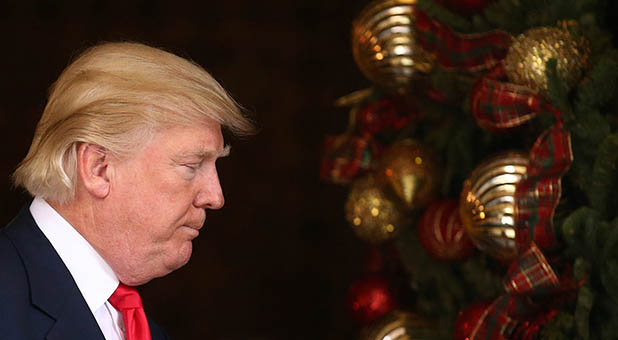There’s Something Special About Christmas and U.S. Presidents
Christmas is a time of celebration and coming together, of letting go of old—and not-so-old—hurts and looking forward to a new day and a new year.
It is a time to remember the ancient proverb, “It is better to light a candle than to curse the darkness.” And this year, it is a prime opportunity to give thanks for a “tree of candles”—the White House Christmas tree—and what it has meant to Americans through the years.
George Washington set the standard in most things as our first president, but he was not the first chief executive to celebrate Christmas in the White House for a simple reason: Construction of the White House was not finished until after he left office in March 1797.
Nevertheless, he and Mrs. Washington entertained family, friends and colleagues at Christmas time during the eight seasons he was our president.
Washington’s most unusual Christmas came in December 1776, when he was the commander in chief of the Continental Army and not yet president.
In the dead of night and with a heavy snow falling, he crossed the Delaware River on Christmas Day with a small force and marched on Trenton, New Jersey, where he surprised and captured some 1,000 Hessian troops and commandeered badly needed supplies.
The surprise attack at Trenton was a turning point of the war and let the British know that the Americans had just begun to fight.
Succeeding presidents were able to celebrate Christmas in a less militant manner. President John Adams and Abigail Adams held the first White House Christmas party in December 1800, inviting the children of official Washington to a party for their 4-year-old granddaughter, Suzannah.
Ever the populist, President Andrew Jackson hosted an elaborate “frolic” in 1834 for the children of his household, complete with games, dancing, a multi-course dinner and an indoor snowball fight with cotton balls.
President Benjamin Harrison erected the first Christmas tree in the White House in 1889, and President Grover Cleveland added electric lights five years later.
Reflecting his ebullient personality, President Theodore Roosevelt in 1903 hosted a “carnival” for 500 children, which included dinner, dancing, entertainment, souvenirs and an ice-cream dessert in the shape of Santa Claus.
President Calvin Coolidge was the first chief executive in 1923 to preside over the National Christmas Tree Lighting ceremony on the Ellipse behind the White House.
In the 1927 ceremony, Coolidge—a more eloquent president than he is generally given credit for—remarked that Christmas was not a time or a season, but “a state of mind. To cherish peace and good will, to be plenteous in mercy, is to have the real spirit of Christmas.”
Sometimes that spirit has been sorely tested. In 1944, when Allied forces were engaged in a two-front war against Nazi Germany and Imperial Japan, President Franklin D. Roosevelt said:
The Christmas spirit lives tonight in the bitter cold of the front lines in Europe and in the heat of the jungles and swamps of Burma and the Pacific islands. Even the roar of our bomber fighters in the air and the guns of our ships at sea will not drown out the messages of Christmas which come to the hearts of our fighting men.
In December 1962, barely a month after the Cuban missile crisis and the possibility of a nuclear conflict had been peacefully resolved, President John F. Kennedy spoke of a “perilous” year in which reason had finally prevailed. “As a result,” he said, “we may talk at this Christmas just a little bit more confidently of peace on earth, good will to men.”
In 1961, first lady Jacqueline Kennedy began the custom of selecting a theme for the White House Christmas tree by decorating with a Nutcracker motif.
In 2008, first lady Laura Bush chose “A Red, White and Blue Christmas,” while first lady Michelle Obama announced in 2010 a White House Christmas theme of “Simple Gifts,” explaining that “the greatest blessings are the ones that don’t cost a thing: the time that we spend with our loved ones, the freedoms we enjoy as Americans and the joy we feel from reaching out to those in need.”
We turn for a last word to President Ronald Reagan, who said in 1981 that “Christmas means so much because of one special child. But Christmas reminds us that all children are special, that they are gifts from God, gifts beyond price that mean more than any presents money can buy.”
Echoing Coolidge, Reagan said that Christmas was “a state of mind … found throughout the year whenever faith overcomes doubt, hope conquers despair and love triumphs over hate.”
With a little catch in his voice, the president ended his Christmas message from the Oval Office by quoting Charles Dickens in A Christmas Carol: “God bless us, every one.”
Amen. {eoa}
Lee Edwards is the distinguished fellow in conservative thought at The Heritage Foundation’s B. Kenneth Simon Center for Principles and Politics. A leading historian of American conservatism, Edwards has published 25 books, including biographies of Ronald Reagan, Barry Goldwater and Edwin Meese III as well as histories of The Heritage Foundation and the movement as a whole.
This article was originally published at DailySignal.com. Used with permission.
















































